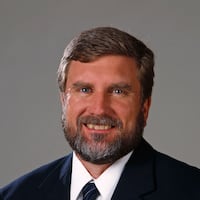Every move in a roughly $1 million organizing effort is aimed at convincing the NCAA to keep its tournament kickoff event — The First Four — in Dayton on a permanent basis.
“We want to keep focused on what we have to do to give ourselves the best chance to have this on a recurring basis,” said J.P. Nauseef, chairman of the First Four Local Organizing Committee. “And anything beyond that, in my view, is a distraction.”
Building around basketball
The First Four — the two-day, four-game event that starts the NCAA men’s basketball tournament — has been played in Dayton both years of its existence and will stay here through 2015. The University of Dayton has submitted a proposal to the NCAA to keep the event for 10 more years. Tim O’Connell, assistant vice president for athletics at UD, said the NCAA has indicated they’ll have “some type of decision” on that front this summer. The NCAA declined to comment.
One reason the region has jumped behind the project is its economic impact.
Jacquelyn Powell, president of the Dayton/Montgomery County Convention & Visitors Bureau, estimated the impact of last year’s First Four and festival at $4 million. This year, with UD also hosting six second- and third-round games, she said a “conservative estimate” is $8 million, which would make it one of the three biggest events of the year for the region.
“Some people may think that this is just a sporting event, but it’s an economic development activity and engine that has been in this region for years,” said Jeff Hoagland, president of the Dayton Development Coalition.
Nauseef, a UD grad who is now managing partner of Myrian Capital, talks about making the First Four “a transformative event” for the community. He pictures not just the return of 2012’s street festival, but the possibility of adding a technology or trade show. And he said Dayton could keep up the “week of basketball” theme if the city could land a conference tournament to lead into Selection Sunday and the First Four.
He said it’s possible Dayton could have a basketball-themed event every year, modeled after the Super Bowl village or Final Four festival.
“The possibilities are only limited by the creativity and innovation of the people in our community, which, guess what, has a legacy and history of being innovative and creative,” he said.
Making an impression
The Local Organizing Committee decided last fall to push for a sellout of all First Four tickets, to show the NCAA how serious it is about wanting to keep the event. O’Connell said once the LOC announced that goal to its partners — local corporations, governments, nonprofits and individuals — the rest of the tickets were sold in five days.
All 12,714 tickets are sold for each day of the First Four, and at noon Friday, only 650 tickets in the upper corners of UD Arena remain for Friday and Sunday’s games. But how many people actually show up for the games is a key issue. In 2011, both First Four sessions drew more than 10,000 fans. But last year that dipped to 8,510 the first day and 7,218 the second day.
“The teams that are selected for the tournament are going to matter, but … with what the LOC has done, I am confident we are going to have a very, very full arena that will be great for TV, great for the participating teams and great for our city,” O’Connell said.
At an LOC meeting Tuesday, key volunteer Matt Farrell of Win Wholesale urged sponsors to check whether all of the tickets they bought were being used, and if not, to get them into the hands of people who would be excited to go.
On the ticket website StubHub.com, more than 1,000 six-game Friday-Sunday ticket packages were listed for resale Friday, ranging from $200 to $2,450. Less than 200 First Four tickets were listed, starting at $45 for Wednesday’s doubleheader.
Fans will learn which teams are headed to UD Arena at 6 p.m. today on CBS, and that will affect ticket demand. Ironically, for a city that touts how close it is to huge swaths of the U.S. population, Dayton has had bad luck landing nearby teams.
In the past two First Fours, only one of the 16 teams selected was within 400 miles of Dayton — Western Kentucky last year. This year, several analysts project that the University of Kentucky will be sent to Dayton for the First Four, with Indiana, Ohio State or both playing at UD on Friday and Sunday.
“I would love to see Kentucky, and I think everybody’s saying that,” Hoagland said. “Just give us one! Kentucky would be huge.”
Nonstop effort
Nauseef stresses over and over that the First Four is a regionwide team effort, with volunteers working nights and weekends.
Dayton International Airport will have its tower lit in NCAA blue this week. The hotels where the teams are staying will play team fight songs and feature team colors and customized key cards. The Convention and Visitors Bureau will greet teams when they arrive, with a red carpet and drummers from Chaminade-Julienne.
Downtown Dayton Partnership President Sandy Gudorf said many property owners will light their buildings all week so the skyline looks good. Local schools, including Wright State, will open their gyms and arenas to give teams private practice time.
The LOC will host a private reception for NCAA officials, teams and sponsors Monday at the National Museum of the U.S. Air Force. They’ll also have a VIP lounge for NCAA staff and national media on game days — all aimed at projecting a positive image of Dayton to the people who could impact whether the First Four stays here.
“Those things stand us up above other cities that might want to host,” O’Connell said. “The amount of volunteer time is unbelievable.”
About the Author
